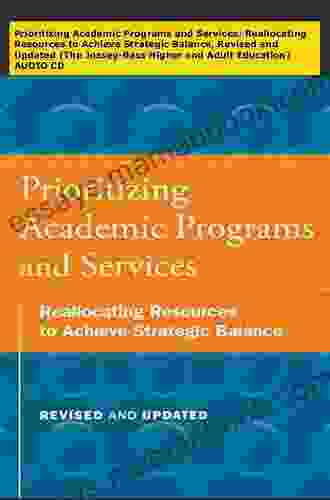Prioritizing Academic Programs and Services: A Comprehensive Guide

In the dynamic and ever-evolving landscape of education, institutions of higher learning face the constant challenge of optimizing their academic offerings and services to meet the needs of students, faculty, and the broader community. Prioritizing academic programs and services is a critical aspect of educational planning and decision-making, as it ensures that resources are allocated effectively and efficiently to support the institution's mission and strategic goals.
4.3 out of 5
| Language | : | English |
| File size | : | 1679 KB |
| Text-to-Speech | : | Enabled |
| Screen Reader | : | Supported |
| Enhanced typesetting | : | Enabled |
| Word Wise | : | Enabled |
| Print length | : | 257 pages |
| Lending | : | Enabled |
This comprehensive guide will delve into the complexities of prioritizing academic programs and services, providing a systematic framework and practical strategies to assist educational administrators in making informed decisions. We will explore a range of factors to consider, from student demand and market trends to faculty expertise and resource availability.
Importance of Prioritizing
Prioritizing academic programs and services is not merely an administrative exercise but a fundamental aspect of educational leadership. By establishing clear priorities, institutions can:
- Focus resources effectively: Limited resources (financial, human, and infrastructural) can be allocated strategically to those programs and services that align most closely with the institution's strategic plan.
- Enhance student success: Prioritizing programs and services that support student learning, engagement, and retention can contribute directly to improved student outcomes.
- Respond to societal needs: Educational institutions have a responsibility to prepare students for the challenges and opportunities of the 21st century. By prioritizing programs and services that address pressing societal issues, institutions can demonstrate their commitment to the public good.
- Enhance institutional reputation: A well-prioritized academic portfolio and service offerings can enhance the institution's reputation for excellence and innovation, attracting top students, faculty, and partners.
Factors to Consider
Prioritizing academic programs and services involves a multifaceted decision-making process that encompasses a wide range of factors, including:
- Student demand: Assessing student interest, enrollment trends, and market research can provide valuable insights into the programs and services that are in high demand.
- Faculty expertise: The availability of qualified and experienced faculty is a cornerstone of any academic program or service. Institutions need to consider the faculty's expertise, research interests, and pedagogical skills.
- Resource availability: Prioritization must take into account the institution's financial resources, physical infrastructure, and technological capabilities. Realistic assessments of available resources can help avoid unsustainable or overly ambitious commitments.
- Institutional mission and goals: The institution's mission statement and strategic plan should serve as guiding principles for prioritizing academic programs and services. Alignment with the institution's core values and strategic objectives is essential.
- External environment: Factors such as industry trends, government policies, and technological advancements can influence the demand for certain programs and services. Institutions need to be responsive to changes in the external environment.
- Quality and outcomes: Data on student learning outcomes, faculty productivity, and stakeholder satisfaction can provide valuable evidence to support prioritization decisions.
Prioritization Framework
To ensure a systematic and evidence-based approach to prioritizing academic programs and services, we propose a comprehensive framework:
- 1. Data collection: Gather data from multiple sources, including student surveys, enrollment statistics, faculty evaluations, and market research.
- 2. Stakeholder engagement: Engage with students, faculty, staff, administrators, and external stakeholders to solicit input and perspectives.
- 3. SWOT analysis: Conduct a thorough SWOT (Strengths, Weaknesses, Opportunities, Threats) analysis to assess the institution's internal capabilities and external challenges.
- 4. Criteria development: Establish a set of criteria for evaluating and prioritizing programs and services, such as student demand, faculty expertise, resource availability, and alignment with institutional goals.
- 5. Weighted evaluation: Assign weights to each criterion based on their relative importance to the institution.
- 6. Prioritization matrix: Create a matrix that lists the programs and services and calculates their weighted scores based on the criteria.
- 7. Decision-making: Use the prioritization matrix as a basis for making informed decisions about resource allocation and program development.
- 8. Monitoring and evaluation: Regularly monitor the effectiveness of the prioritized programs and services and make adjustments as needed based on emerging data and stakeholder feedback.
Practical Strategies
In addition to the prioritization framework, institutions can employ a range of practical strategies to enhance the effectiveness of their academic programs and services:
- Collaborate with external partners: Partnerships with businesses, industry leaders, and community organizations can provide valuable insights, resources, and opportunities for program development and student engagement.
- Promote interdisciplinary collaboration: Encourage faculty from different disciplines to work together on the development of innovative programs and research initiatives.
- Utilize technology: Integrate technology into teaching and learning to enhance the student experience, improve student outcomes, and reduce costs.
- Embrace innovation: Foster a culture of innovation and experimentation in academic programs and services, encouraging out-of-the-box thinking and creative solutions.
- Seek external funding: Explore opportunities for external funding, such as grants, scholarships, and partnerships, to support the development and expansion of academic programs and services.
Prioritizing academic programs and services is a complex and ongoing process that requires a systematic approach, thoughtful consideration of multiple factors, and a commitment to evidence-based decision-making. By embracing the strategies and frameworks outlined in this guide, educational institutions can allocate their resources effectively, enhance student success, respond to societal needs, and establish themselves as leaders in the dynamic and ever-changing landscape of higher education.
Remember, the ultimate goal of prioritization is to create an academic environment that empowers students, challenges faculty, and enables the institution to achieve its mission and strategic objectives. By embracing a collaborative, data-driven, and forward-thinking approach, institutions can ensure that their academic programs and services remain relevant, innovative, and impactful.
4.3 out of 5
| Language | : | English |
| File size | : | 1679 KB |
| Text-to-Speech | : | Enabled |
| Screen Reader | : | Supported |
| Enhanced typesetting | : | Enabled |
| Word Wise | : | Enabled |
| Print length | : | 257 pages |
| Lending | : | Enabled |
Do you want to contribute by writing guest posts on this blog?
Please contact us and send us a resume of previous articles that you have written.
 Top Book
Top Book Novel
Novel Fiction
Fiction Nonfiction
Nonfiction Literature
Literature Paperback
Paperback Hardcover
Hardcover E-book
E-book Audiobook
Audiobook Bestseller
Bestseller Classic
Classic Mystery
Mystery Thriller
Thriller Romance
Romance Fantasy
Fantasy Science Fiction
Science Fiction Biography
Biography Memoir
Memoir Autobiography
Autobiography Poetry
Poetry Drama
Drama Historical Fiction
Historical Fiction Self-help
Self-help Young Adult
Young Adult Childrens Books
Childrens Books Graphic Novel
Graphic Novel Anthology
Anthology Series
Series Encyclopedia
Encyclopedia Reference
Reference Guidebook
Guidebook Textbook
Textbook Workbook
Workbook Journal
Journal Diary
Diary Manuscript
Manuscript Folio
Folio Pulp Fiction
Pulp Fiction Short Stories
Short Stories Fairy Tales
Fairy Tales Fables
Fables Mythology
Mythology Philosophy
Philosophy Religion
Religion Spirituality
Spirituality Essays
Essays Critique
Critique Commentary
Commentary Glossary
Glossary Bibliography
Bibliography Index
Index Table of Contents
Table of Contents Preface
Preface Introduction
Introduction Foreword
Foreword Afterword
Afterword Appendices
Appendices Annotations
Annotations Footnotes
Footnotes Epilogue
Epilogue Prologue
Prologue Jerry D Young
Jerry D Young Emily Skinner
Emily Skinner Elaine Royal
Elaine Royal Zoltan Bartok
Zoltan Bartok Adoracion Berandoy
Adoracion Berandoy Geoffrey Peyton
Geoffrey Peyton Darrell Morris
Darrell Morris Ed Conway
Ed Conway Brock Clarke
Brock Clarke L J Hachmeister
L J Hachmeister Sharon V Kramer
Sharon V Kramer Ellen Bass
Ellen Bass Adam Wasserman
Adam Wasserman Assata Shakur
Assata Shakur Jay W Carender
Jay W Carender David Smith
David Smith Maureen Howard
Maureen Howard Clara Wils
Clara Wils Audrey Monke
Audrey Monke Ronald Eugene Isetti
Ronald Eugene Isetti
Light bulbAdvertise smarter! Our strategic ad space ensures maximum exposure. Reserve your spot today!
 Ian PowellFollow ·17.5k
Ian PowellFollow ·17.5k Vladimir NabokovFollow ·15.6k
Vladimir NabokovFollow ·15.6k Larry ReedFollow ·16.3k
Larry ReedFollow ·16.3k Jessie CoxFollow ·4.3k
Jessie CoxFollow ·4.3k Hugh BellFollow ·3.4k
Hugh BellFollow ·3.4k H.G. WellsFollow ·7.2k
H.G. WellsFollow ·7.2k Allen GinsbergFollow ·13.7k
Allen GinsbergFollow ·13.7k Patrick HayesFollow ·2.7k
Patrick HayesFollow ·2.7k

 Dean Butler
Dean ButlerBlack Widow 2024: A Comprehensive Guide to Kelly...
In 2024, Marvel...

 Gage Hayes
Gage HayesNothing and the Speck: An In-Depth Analysis of Yana...
Yana Toboso's works, particularly the manga...

 Stan Ward
Stan WardThe Best American Poetry 1997: James Tate
The Best American Poetry...

 Corey Green
Corey GreenThe Chance of Home: Exploring the Poetic Landscape of...
Immerse yourself in the evocative world of...
4.3 out of 5
| Language | : | English |
| File size | : | 1679 KB |
| Text-to-Speech | : | Enabled |
| Screen Reader | : | Supported |
| Enhanced typesetting | : | Enabled |
| Word Wise | : | Enabled |
| Print length | : | 257 pages |
| Lending | : | Enabled |














